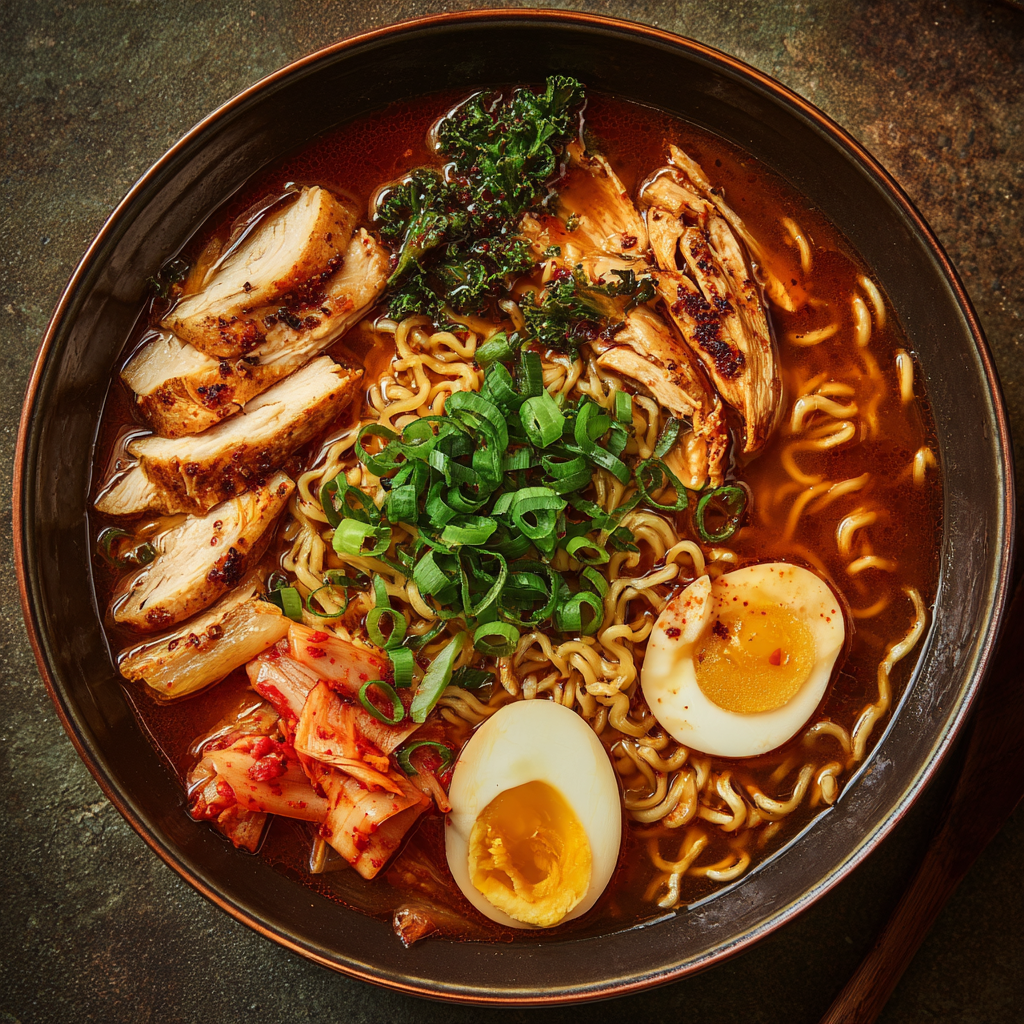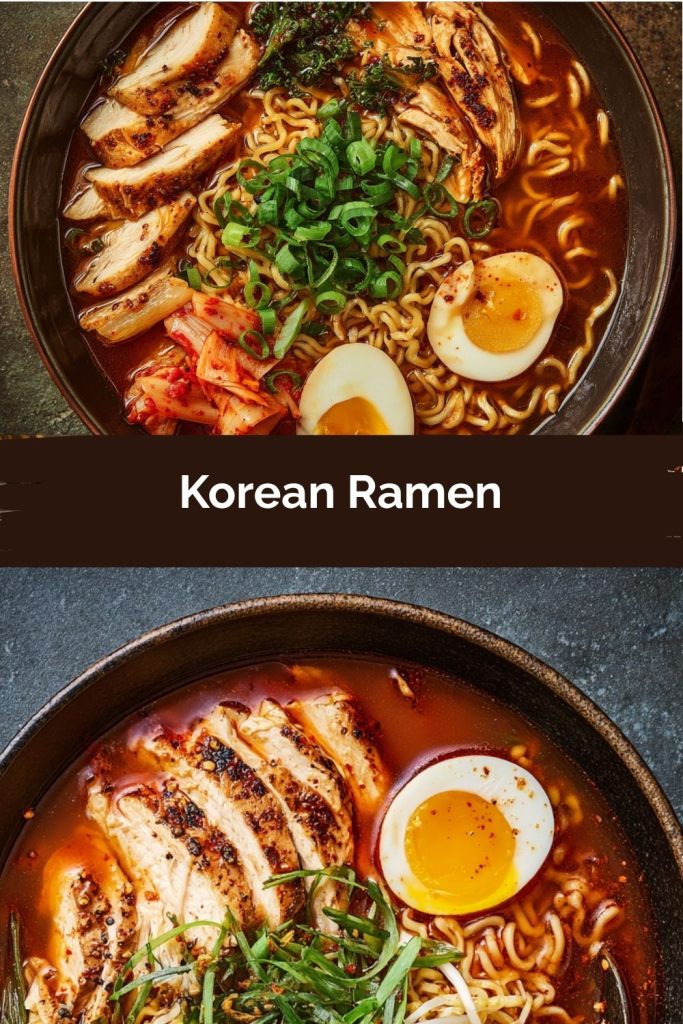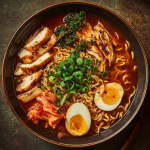Korean Ramen: Your New Favorite Spicy-Savory Hug in a Bowl
Hey friends, Wyatt here! Pull up a stool and let’s talk about something that’s been absolutely rocking my kitchen lately: Korean Ramen. This ain’t your college dorm instant stuff (no shade, we’ve all been there!). This is a soul-warming, flavor-bomb masterpiece – spicy, savory, deeply comforting, and packed with layers of umami that’ll make your taste buds do a happy dance. Imagine tender chicken, chewy noodles, and a broth that’s got this incredible depth from gochujang and friends, all topped with jammy eggs and crunchy bits. It’s like a warm hug with a friendly little kick, the perfect antidote to a grey day or a celebration of just… Tuesday! The best part? It’s way easier than you think. No fancy techniques, no obscure tools – just good ingredients and a little simmering magic. Whether you’re a kimchi connoisseur or just dipping your toes into Korean flavors, this bowl is your gateway to pure, steamy deliciousness. So grab your favorite pot, and let’s turn up the heat together!
The Blizzard Bowl That Started It All
PrintKorean Ramen
This Korean-style ramen is a spicy, savory, soul-warming bowl of comfort—layered with bold umami, tender chicken, and the deep heat of gochujang. It’s the kind of noodle soup that feels like a warm hug with a kick. Customize it with your favorite toppings and make it your own noodle masterpiece.
- Prep Time: 15 mins
- Cook Time: 40 mins
- Total Time: 55 mins
- Yield: 2–3 1x
Ingredients
For the Broth:
4 cups chicken stock
4 tsp gochujang (Korean chili paste)
1 tsp doenjang (Korean soybean paste, optional)
2 tsp shiro miso (white miso)
1 tsp coarse gochugaru (Korean chili flakes)
1 tsp fish sauce
4 skinless chicken thighs
For the Ramen:
4–5 oz Japanese ramen noodles (non-instant)
2 large eggs
Green onions, enoki mushrooms, kimchi – to garnish
Reserved cooked chicken
Prepared Korean ramen broth
Instructions
Make the Broth: In a pot, combine chicken stock, gochujang, doenjang (if using), miso, gochugaru, fish sauce, and chicken thighs. Bring to a boil, then simmer gently for 30–40 mins. Remove chicken and shred; strain the broth if needed.
Cook the Eggs: Soft-boil eggs (6–7 mins), then cool and peel.
Cook the Noodles: Boil ramen noodles according to package instructions. Drain and set aside.
Assemble the Ramen: Divide noodles into bowls. Top with shredded chicken, soft-boiled eggs, and your favorite garnishes.
Ladle the Broth: Pour hot broth over the toppings and serve immediately.
Notes
A steamy bowl of spice, umami, and comfort—Korean ramen hits every note
Nutrition
- Calories: 450–500
- Fat: 18g
- Carbohydrates: 40g
- Protein: 30g
This recipe actually has its roots in one of the wildest snowstorms I’ve ever seen. Picture it: roads vanished, power flickering, and the grocery store shelves looking mighty bare. My buddy Jin, trapped at my place after a game night gone long, just grinned and said, “Wyatt, we make magic with what we have.” We raided the pantry – found some forgotten gochujang, a lone pack of ramen noodles (the good kind!), leftover roast chicken, and a couple of eggs clinging on in the fridge. Jin started building this broth, layering in chili paste, a dash of soy sauce (no doenjang in sight!), whispering about his grandma’s secret “whatever’s in the fridge” stews. The smell alone thawed our frozen toes! Huddled around the stove, slurping those spicy, improvised noodles while the wind howled outside… man, it was pure, steaming comfort. It wasn’t fancy, but it was soul-deep satisfying. That “Blizzard Bowl” became legendary among our friends, and it’s the spirit I chase every time I make this ramen – resourceful, warming, and best shared. It reminds me that great food isn’t about perfection; it’s about heart, a little heat, and filling your people up.
Gathering Your Flavor Arsenal
Here’s the lineup for that incredible Korean ramen magic! Don’t stress if you need to swap something – cooking’s an adventure, right?
- Chicken Stock (4 cups): The soulful base! Homemade is gold, but a good quality store-bought low-sodium works beautifully. Insider Tip: Simmer store-bought stock with an extra onion half and a chunk of ginger for 15 mins to amp up the flavor before adding other ingredients.
- Gochujang (4 tsp): The MVP! This fermented Korean chili paste brings complex sweetness, heat, and that signature deep red color. Sub Alert: In a pinch, mix 3 tsp sriracha + 1 tsp miso paste + 1/2 tsp sugar, but it won’t be quite the same.
- Doenjang (1 tsp, optional): Korean fermented soybean paste. Adds a deep, funky umami punch. Don’t Have It? No sweat! Double the miso or skip it. The ramen still sings!
- Shiro Miso (2 tsp): White miso paste. Lighter and sweeter than red, it balances the heat beautifully and adds savory depth. Sub: Yellow miso works fine too.
- Coarse Gochugaru (1 tsp): Korean chili flakes. They add texture and a brighter, fruitier heat than just gochujang. Heat Level: Use less if sensitive, or swap in regular crushed red pepper (use half the amount, it’s hotter!).
- Fish Sauce (1 tsp): The stealth umami booster! Don’t worry, it won’t taste fishy. Veggie Swap: Use soy sauce or tamari.
- Skinless Chicken Thighs (4): Thighs stay juicy and flavorful during simmering. Sub: Chicken breast works (reduce simmer time to 20-25 mins) or leftover rotisserie chicken (add shredded chicken at the end).
- Japanese Ramen Noodles (4–5 oz, non-instant): Look for fresh or dried ramen noodles in the Asian aisle. Key: Avoid instant noodle seasoning packets! Sub: Udon or even thick spaghetti in a real pinch.
- Large Eggs (2): For those glorious jammy soft-boils! Pro Move: Use room temp eggs for easier peeling.
- Garnishes (Green onions, Enoki mushrooms, Kimchi): The fun part! Green onions for freshness, enoki for delicate crunch, kimchi for tangy-spicy punch. Go Wild: Add sautéed shiitake, spinach, corn, sesame seeds, nori strips!
Let’s Build That Beautiful Bowl: Step-by-Step
Alright, team! Time to fire up the stove and make some magic happen. Grab your favorite heavy-bottomed pot – this is where the flavor symphony begins.
- Build the Broth Base & Simmer: “In your pot, combine the chicken stock, gochujang, doenjang (if using), miso, gochugaru, fish sauce, and those chicken thighs. Whisk it all together really well – you want those pastes fully dissolved. Chef’s Hack: Spoon the pastes into a small strainer and dip it into the stock, using a whisk or spoon to push them through right into the liquid. No lumps! Bring this gorgeous mixture to a gentle boil over medium-high heat. Once it’s bubbling happily, reduce the heat to low. You want a quiet simmer – think lazy bubbles breaking the surface occasionally, not a rolling boil. Pop a lid on slightly askew and let it bubble away gently for 30-40 minutes. This slow simmer coaxes out all the incredible flavors from the chicken and pastes, creating a deeply rich and complex broth. Pro Tip: Set a timer! You don’t want the chicken to overcook and get stringy. The thighs are done when they easily pull apart with a fork.”
- Rescue the Chicken & Strain (If Needed): “Carefully fish out those beautiful chicken thighs using tongs and plop them onto a cutting board. Let them cool just enough so you can handle them – about 5 minutes should do it. Now, get shredding! Use two forks or your (clean!) fingers to pull the chicken into nice, bite-sized pieces. Set this juicy goodness aside. Take a peek at your broth. See any little bits or stray spices? If you want a super smooth broth (my preference for elegance!), pour it through a fine-mesh strainer into a clean pot or large heatproof bowl. If you dig a bit more rustic texture (and don’t mind tiny chili flecks!), you can skip straining. Taste it now – isn’t that depth incredible? Safety Note: Broth is lava-hot! Handle carefully.”
- Perfect the Jammy Eggs: “While the broth simmers, tackle the eggs. Bring a small saucepan of water to a rolling boil (enough to cover the eggs by an inch). Gently lower in your room-temp eggs using a spoon – this prevents cracking! Set your timer for exactly 6 minutes and 30 seconds for perfectly jammy yolks. While they cook, prepare an ice bath: fill a bowl with cold water and plenty of ice cubes. When the timer dings, immediately transfer the eggs to the ice bath using a slotted spoon. Let them chill completely for at least 5 minutes. This stops the cooking and makes peeling a breeze. Once cold, gently tap each egg all over on the counter, then roll it gently between your hands to loosen the shell. Peel under cool running water – it helps! Slice them in half just before serving. Timing Tip: Do this step while the chicken simmers for efficiency!”
- Noodle Nirvana: “Bring another pot of water to a boil for your noodles. Follow the package directions carefully – cooking times vary wildly! Usually, it’s 3-5 minutes for fresh, 4-7 for dried. You want them al dente – tender but still with a bit of bite. They’ll soften slightly in the hot broth later. Critical Step: Drain them IMMEDIATELY when done and give them a quick rinse under cold water to stop the cooking. Toss them with a tiny splash of neutral oil (like canola) to prevent sticking. Nobody wants a noodle brick!”
- The Grand Assembly: “This is where the fun really starts! Divide your perfectly cooked, slightly slick noodles between your favorite deep bowls. Artfully pile that beautiful shredded chicken right on top. Nestle in those halved jammy eggs, yolks gleaming. Now, unleash your garnish game! Scatter sliced green onions, a tangle of enoki mushrooms (raw for crunch or quickly sautéed for depth), and a generous spoonful of tangy kimchi. Presentation Pro Tip: Group toppings in little piles for visual pop! Finally, the moment of truth: carefully ladle that steaming, fragrant, deeply flavored Korean broth over everything. Listen to that glorious sizzle as it hits the cool toppings! Serve it up immediately – this ramen waits for no one.”
Slurp in Style: Serving It Up Right
This Korean ramen is a showstopper straight out of the pot, but a few little touches make it sing! Grab those deep, wide bowls – you need room for all that goodness and a proper slurping angle. The key is contrast and freshness against the rich broth. Pile those garnishes high! Don’t just sprinkle the green onions; make a vibrant green stripe. Let the bright red kimchi and pale enoki mushrooms peek out invitingly. A final flourish? A light shower of toasted sesame seeds or a tiny drizzle of toasted sesame oil right before serving adds incredible aroma. Serve it piping hot with extra kimchi on the side and maybe some Korean chili threads (silgochu) for the heat-seekers. And the most important serving suggestion? Chopsticks and a big Asian soup spoon are mandatory for maximum enjoyment. Dig in, get messy, and slurp loudly – it’s the highest compliment to the chef!
Make It Your Own: Delicious Twists
This Korean ramen is your canvas! Here are some tasty ways to mix it up:
- Seafood Fiesta: Swap chicken thighs for shrimp (add raw in the last 2-3 mins of broth simmering) or scallops. Use dashi or seafood stock instead of chicken for extra ocean vibes!
- Veggie Powerhouse: Skip the chicken and fish sauce. Use veggie broth, add cubed tofu (pan-fry first for texture!), extra mushrooms (shiitake, oyster), bok choy, and sweet corn. Boost umami with a splash of soy sauce/tamari instead of fish sauce.
- Spicy Tteokbokki Fusion: Add a handful of Korean rice cakes (tteok) to the broth during the last 5 minutes of simmering for delightful chewy bites alongside the noodles. Increase gochujang by 1 tsp for extra kick!
- Creamy Coconut Dream: Stir in 1/2 cup of full-fat coconut milk into the broth right before serving for a luscious, slightly sweet, Thai-Korean fusion twist. Garnish with cilantro and lime.
- Breakfast Ramen: Top with a crispy fried egg instead of soft-boiled and add some crumbled cooked bacon alongside the chicken. Unconventional? Maybe. Delicious? Absolutely.
Wyatt’s Whispered Wisdom: Chef’s Notes
Man, this recipe has come a long way since that blizzard! The biggest evolution? Straining the broth. Early on, I loved the rustic look, but straining it creates this velvety, restaurant-quality texture that lets every flavor shine without distraction. Worth the extra bowl to wash! Funny story? I once accidentally used black bean paste (chunjang) instead of doenjang. Whoops! It turned the broth an interesting shade of dark brown and added a wild, sweet-bean dimension. Not “Korean Ramen” anymore, but surprisingly tasty! Lesson learned: label your jars! Another tip? Don’t skip the ice bath for the eggs. I tried the “run under cold tap water” method once in a rush… let’s just say peeling was an exercise in frustration and my yolks were overcooked. Patience pays off with perfect jammy goodness! This dish is forgiving. Broth too spicy? Stir in a teaspoon of honey or sugar. Too salty? Add a splash more water or stock. Make it yours, share it often, and always listen to that pot – it’s telling you a delicious story.
Ramen Rescue: FAQs & Fixes
Ran into a ramen wrinkle? Don’t sweat it! Here’s the scoop on common hiccups:
- Q: My broth isn’t spicy enough! Help!A: Easy fix! Start by stirring in an extra 1/2 teaspoon of gochujang OR a pinch more gochugaru. Taste! Remember, the heat builds slightly as it simmers and as you eat. You can also serve with extra gochugaru or a drizzle of Korean chili oil (rayu) on the side for folks to customize. Don’t dump a ton in at once – you can always add heat, but you can’t take it out!
- Q: Broth tastes a bit flat or one-dimensional. What did I miss?A: Depth is key! First, ensure you simmered it long enough (full 30-40 mins). If you did, try these boosts: A splash more fish sauce (1/4 tsp) or soy sauce for salt/umami. A tiny pinch of MSG (don’t hate, it works wonders!). Simmer a 1-inch piece of kombu (dried kelp) in the broth for 10 mins before adding the pastes/chicken (remove it before adding pastes). Or, sauté 2-3 minced garlic cloves and a 1-inch knob of grated ginger in the pot before adding the stock.
- Q: My noodles got mushy or clumped together. Disaster?A: Noodle mishaps happen! Prevention: Cook noodles *just* until al dente (they cook more in the broth). Rinse WELL with cold water immediately after draining to stop cooking and remove excess starch. Toss with a tiny bit of oil. Rescue: If they clumped *before* adding broth, try running hot water over them

-
Final Thoughts: The Slurp Heard ’Round the Kitchen
So there you have it, friend—a bowl of Korean ramen that’s equal parts comfort and kick, steeped in story and stacked with flavor. Whether you’re chasing off a cold snap, feeding your favorite people, or just need a dinner that hits like your favorite song, this ramen’s got your back. It’s proof that pantry staples, a little spice, and a lotta love can turn even the chilliest night into something legendary. So grab your spoon, crack that jammy egg, and slurp like nobody’s judging—because in my kitchen, loud noodles are a love language.

